
Another resurrected article. Cinema Rising was a short-lived newsprint film magazine that ran for three issues in the UK in 1972. I have a few pages from the rare first issue that was part of a batch of old underground newspapers I was given a few years ago. (The Frendz Hawkwind strip is from the same haul.) Cinema Rising was edited by Simon Hartog and Tony Rayns, the latter being a long-time Kenneth Anger aficionado which would explain both the magazine title and the presence of a photo feature about Anger’s Lucifer Rising. The bulk of this post is a short interview with Donald Cammell that’s of interest for his comments about the gender roles in Performance and his opinion of Jorge Luis Borges whose recurrence as both signifying text and presiding magus in Performance is never really explained.
Cammell’s next film after Performance would have been Ishtar (no relation to the notorious Warren Beatty flop), the themes of which Cammell discusses at the end of the piece. The Cammell biography describes a script concerning a film star and Hollywood producer who want to make a film in Morocco. While there they get involved with a woman who embodies various mystical/mythological feminine attributes; there’s also a sub-plot about the pair kidnapping an American judge. Mick Jagger was down for the role of the film star while William Burroughs was slated to play the judge. Given how wayward Cammell’s later films became it’s difficult to say whether this would have been good or not. Performance could very easily have been terrible but that film also had Nicolas Roeg on board.
After the Cammell piece there are photos from Cinema Rising‘s Kenneth Anger feature which show the director at work on the new version of Lucifer Rising. I’ve not seen any of these stills or the two black actors before—what happened to their parts? Note that some of the captions are misspelled: the photos should be credited to Diarmid Cammell—Donald’s brother—while the Adept (not “Lucifer”) is Haydn Couts. •

DONALD CAMMELL: PERFORMANCE TO ISHTAR, Cinema Rising, no. 1, April 1972
Donald Cammell’s first movie was Performance, made in collaboration with Nicolas Roeg; the most unexpected British movie of recent years, and one of the very few products of the British industry capable of holding its own in an international context. Cammell’s new script is Ishtar, originally written with Mick Jagger in mind for the lead again, but possibly to be made without him; Cammell is currently in America to raise the backing for the film.
In the following extracts from a conversation with John du Cane (recorded last year), Cammell speaks of his background and interests…matters that inform his new script at least as much Performance.
Collaboration
“In the recent past, reverence for the director of a film as sole creator has been vastly exaggerated, through critical efforts. I’m thinking particularly of the Cahiers du Cinema ‘author’ concept—I’ve been living in Paris, and have been quite aware of it for a long time. The kind of theory of creativity that’s arisen there (and in related worlds in New York) is, succinctly, crap. It’s a way of trying to demonstrate the view that cinema is an artform, and that therefore there must be a single creative mind controlling the artefact, through to its ultimate form. It’s a way of justifying movie-making, socially and culturally.
“But leaving aside the reasons for the concept, I think it’s contradicted by the facts. I think that many of the greatest artefacts things that have moved people most throughout history—have been collectively produced. You don’t even have to look for examples: the whole of Egyptian culture, arcane cultures generally. Today in tribal cultures, the vast majority of the products are collectively produced. The hangup is the concept of one ego necessarily controlling the production in order for that ego to be expressed; the notion that the expression of an ego is the final goal of any artwork, that this is what it’s for. I think that an artwork expresses itself, that the creators involved will all see in it their own egos, each one individually satisfied when looking at the final work. My analogy is with contemporary music, where people go into it collectively, and their egos are satisfied collectively and individually. Look at Mick and Keith and their confreres: they see in their work as The Rolling Stones what they each wanted to say. Working in the film medium is ideally suited to interaction of different heads; it’s the ideal medium for all the good functions of collective work.”
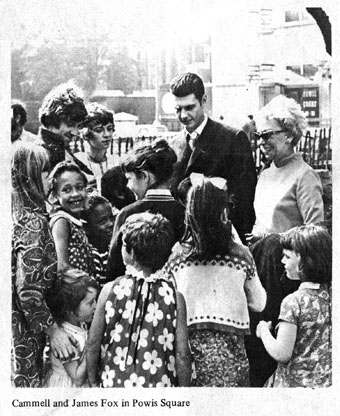
Magick
“My interest in Magick is really a matter of being conditioned, because I was brought up in a house where Magick was real. My old man, Charles, long gone these three years, filled the house with magicians, metaphysicians spiritualists and demons. I was conditioned by my father, by his books (that library…), by Aleister Crowley. I reacted against that at one stage: I became very materialist, obsessed by science and physics. But later I became more and more conscious that the world I was brought up in was an expression of a reality. I dug Magick and wanted to find out more. The performance of Magick is an extremely difficult thing, magical processes are hardly ever achieved, and we have very little experience of it outside the tribal cultures that manage it. It functions in those countries in a pragmatic, material way…which is what Magick is: the raising of demons for the purpose of performing in the physical world in the interests of the magician, who is ideally a benevolent person, wanting to use the forces for what he conceives to be proper ends for all mankind. The interface of black and white magic is simply the difference in using powers on hand that are neither good nor bad, but that have both faces—the demonic face of a spirit is as much part of it as its angelic face. Kenneth (Anger) is better qualified to discuss the specific relationship between Magick as we know it culturally/historically and pragmatically. Which is to say, performing it, through a vehicle that of all the vehicles we have invented to influence other men’s minds and communicate is logically the most powerful: the moving picture with its attendant sound.”

Jorge Luis Borges
“There is a symmetry about Borges’ thought which is an exemplary model for anyone trying to make a movie. I try to rationalise my admiration for his method of thinking as an ideal that I’d like to aim at when making a movie. The economy especially; the use of suggestion and analogy, with a kind of phrasing and choice of images that’s amusing in a purely sensual way; and then the layers of meaning, almost word-upon-word in a Borges sentence. I know of no other writer who achieves it as well as Borges does. He admires G. K. Chesterton very much—Catholic metaphysics being talked about in detective stories—but the ideas are not of so much interest to me there, they’re simply not of the same order. The cyclical nature of Borges’ stories: they’re repetitions of the same inter-enactments of archetypal figures that have happened, are happening and will continue to happen until people get the message, and work out solutions to the paradoxes. In all the incredible, arcane, encyclopaedic literature that he’s perused, he finds reenactments of ideas, and of stories; and on the most romantic level of violence, he sees enactments of paradoxical paradoxes, that cannot be resolved. Paradox can be used the way that Borges does (and the way that Socrates, Zeno and the Athenian rustic philosophers he quotes did), the poetic ambiguities being a method of raising real tensions in an audience: to put it simplistically, they can’t resolve the black and white in one individual, man’s existence as both thinking creature and violent animal. The nature of a paradox is that there’s no solution to it on the level of the paradox itself. A paradox is a logical presentation of a not illogical situation that has no logical solution. It’s a demonstration that logic is not the essence of interaction; materialism does not account for all the manifestations of energy.”
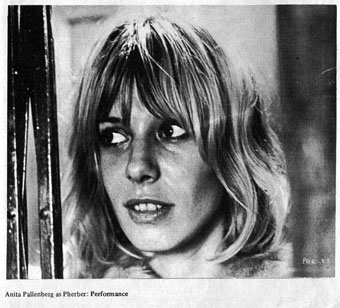
Sexual archetypes
“In defining the axis in each man between Apollo and Dionysus, I’ve found it more interesting mythologically to see Achilles and Hercules as manifestations of the Apollonian principle, and Dionysus as represented in the forms of Astarte, Aphrodite, Isis, Ishtar. The names you note, have less savage connotations.
“I think that the Dionysiac ritual is the story of the female’s fury at the male’s psychic homosexuality, the male in love with himself, with his power, unable to evolve beyond that brute level because he gets his rocks off that way. The aspect of the Apollo figure that interested me in Performance was the more violent form, as Hercules or Achilles (as described by Robert Graves: ‘the narrow lips and narrow hips’). He, with all his grandeur, glamour and magnetism for males is standing squarely across the ocean that must be navigated by the female element—not 100% female, but that end of the creative, generative spectrum that we think of as female, as embodied in Dionysus and the Bacchantes, who became very tough with men when they were permitted.
“Throughout history, the male mass has only ever been able to manifest itself in an Apollonian fashion; so that when men in all their glory enter into their cerebral world, as old men they continue to function but also dishonestly continue to encourage the young men to provide the Apollonian spectacle of destruction that amuses the Apollonian thinkers in their long white robes… (When Socrates received Alcibiades, who was the very type of Apollonian glory, he revealed his love in terms of loving Alcibiades’ soul and his mind… and was rebuked by the Orphic oracle who told him that she was disgusted by the love of male-soul for male-soul. Obviously she dug males fucking each other, but that didn’t come into it, that’s a different scene.)
“So the male is so in love with himself that he no longer understands the Dionysiac, the Astarte, who must be received and allowed to operate because she can’t act through force. The Bacchantes when they ran wild must have been demonstrating that they could meet the males on that ground and destroy them, but normally they operate in the way that Pherber (Anita Pallenberg) operates in Performance, on a human level. Dionysus is an embodiment of man’s suppression of the female, the horrible state that males and females can arrive at. I’d love to make a movie one day about a male who knows that he must find out about the female within himself, again using a female, (like Turner’s collaboration with Pherber), so that the girl is trying to give herself to him, to work off her own surfeit of male psyche.
“Women every where are forced and conditioned into being too masculine; see Women’s Lib in America, where women have become masculinised out of recognition. They’re entrapped by men because they’re weaker on the realistic level of operation. They cannot operate on a physical level with the power and effectiveness of men, because they did not evolve for that. Man himself must take the masochistic attitude of giving power to the weaker, because that’s the only way he’ll find a resolution for his own sexual paradox…” •
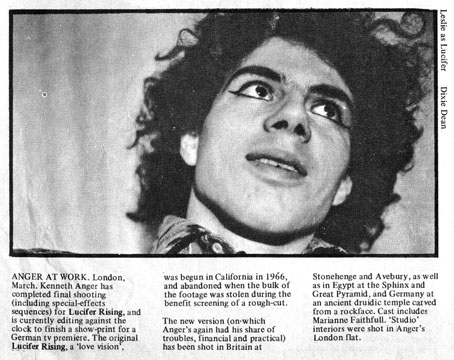
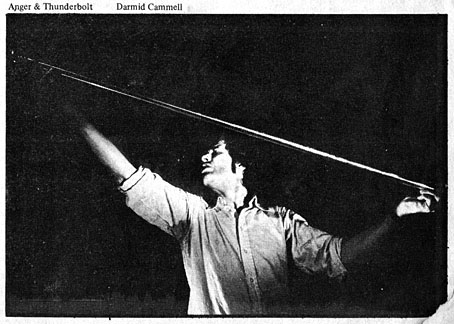
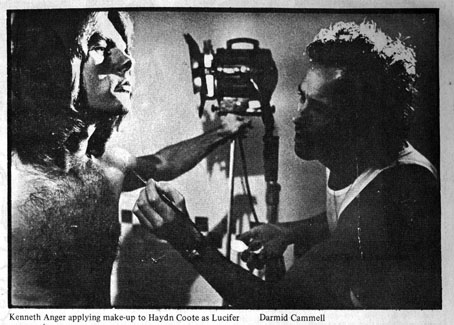
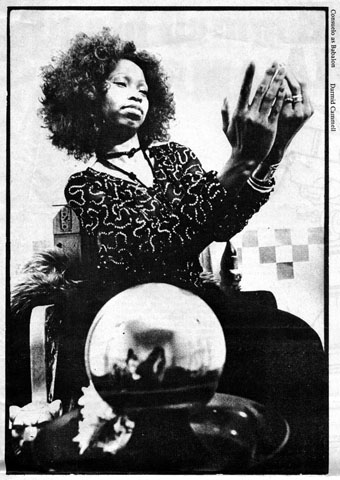
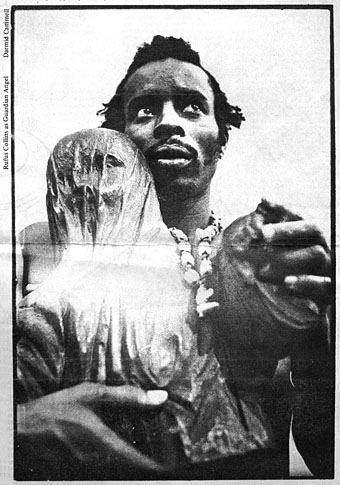

Previously on { feuilleton }
• My Surfing Lucifer by Kenneth Anger
• Inauguration of the Pleasure Dome: The Eldorado Edition
• Brush of Baphomet by Kenneth Anger
• Anger Sees Red
• Kenneth Anger’s Hollywood Babylon
• Lucifer Rising posters
• Missoni by Kenneth Anger
• Anger in London
• Arabesque for Kenneth Anger by Marie Menken
• Edmund Teske
• Kenneth Anger on DVD again
• Mouse Heaven by Kenneth Anger
• The Man We Want to Hang by Kenneth Anger
• Relighting the Magick Lantern
• Further back and faster
• Kenneth Anger on DVD…finally
• Quite a performance
• Borges in Performance
